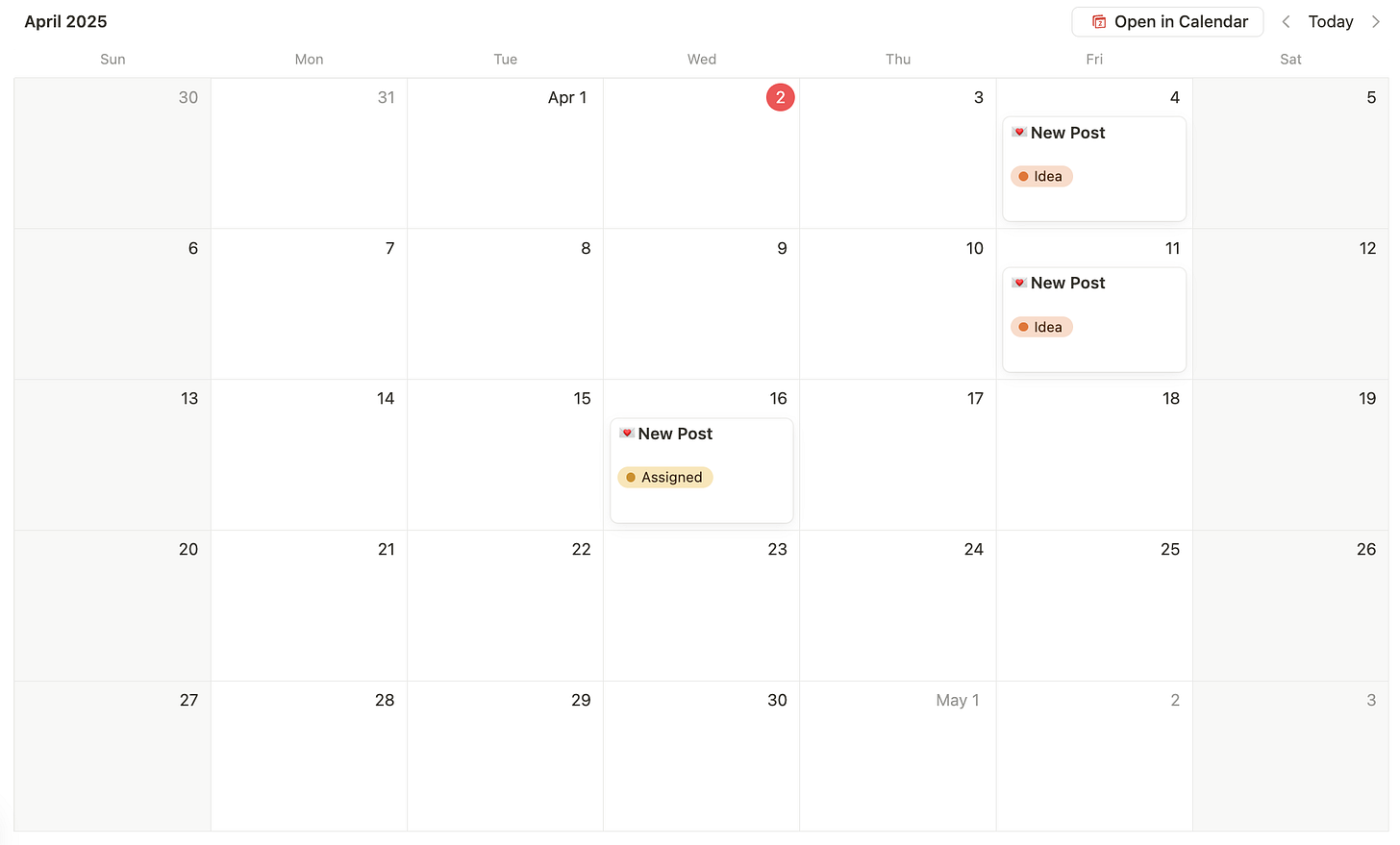Your midweek dose of content clarity, delivered in brief to help you go from frazzled content creator to confident conversation leader. ⚡️ Subscribe here.
This post is part of a special 5-day event for members—the Done in Days: Content System Sprint! By the end of this week, you’ll have a working content system—a complete content command center to house your workflow and turn your method into momentum. 🪄 Find each day here.
We are nearing the finish line!
And look at you go—you've defined your content direction, developed your unique content pillars and created your ideal content mix. 🪄
Today we're tackling the content calendar. But don't worry! We're not building a rigid prison for your creativity—we're creating a flexible home for your ideas to thrive. A good content calendar works for you, not against you.
Think of it as your content GPS—it helps you know where you're going without dictating every turn along the way. 🗺️
Quick reminder on how this works:
Over these five days, I’ll show up like this in your inbox with short, impactful tasks to help you build a content system that works with your natural creative flow, captures your best ideas and helps you create consistently without the overwhelm.
You can DIY your own content system as we go in whatever project management tool you prefer, or you can skip right on ahead and grab my done-for-you template. It’s normally $57 but available for $37 during this week’s content sprint! (Want to see inside? Get the full tour here.)
Not a member of The Content Brief? What are you waiting for? Join us and go from frazzled content creator to confident conversation leader, starting with this Done in Days: Content System Sprint!
Most content calendars end up abandoned by February. Why? Because they're too rigid, too detailed or just too disconnected from how you actually create.
Here’s what we want to avoid:
❌ Scheduling specific content too far in advance (killing spontaneity)
❌ Creating overly complex systems (that require a PhD to maintain)
❌ Focusing on quantity over quality (burning you out)
❌ Ignoring your natural creative rhythms (fighting against your flow)
Instead, we’re building a calendar that:
✅ Provides structure without stifling creativity
✅ Respects your actual capacity and energy
✅ Leaves room for inspiration and opportunity
✅ Makes content creation easier, not harder
The Calendar Components You Need
A good content calendar has these essential elements:
1. Content Overview
This is your bird's-eye view—what's coming up across platforms and channels. I like to have a calendar view for this, which quickly shows publication dates, working title/concept and status.
2. Content Details
This is where you capture the specifics for each piece:
Related content pillar
Related content campaign
Key message/purpose
Call to action
Notes/ideas
3. Creation Workflow
This tracks the status of each piece as it moves through your process: Idea, Assigned, Drafting, Editing and finally Published.
4. Idea Bank
This is your storehouse of ideas for future use—little sparks of ideas you might want to further develop. I organize these by content pillar so I can also quickly see how well I’m balancing content across themes.
Building Your Calendar Structure
You have so many options when it comes to where to set up a system that works for you. There are digital tools from Notion (my personal favorite), to Trello, Asana, Clickup, Airtable or event Google Calendar and analog options like an old-fashioned paper planner or wall calendar.
Choose the option that feels most natural to you. The best system is the one you'll actually use!
Here are a few elements to consider in any basic framework:
Step 1: Create Your Overview
Set up a monthly or quarterly view that shows:
Publication dates across channels
Content types (from your mix in Day 3)
Key themes or topics
Important dates (launches, promotions, holidays)
Step 2: Establish Your Workflow
Create a system to track content status:
Idea stage: Concepts you're considering
Drafting stage: Content being researched/outlined/drafted
Editing stage: Content being edited/finalized
Published stage: Content that's live in the world
Step 3: Build Your Idea Bank
Set up a place to capture content ideas that includes:
Related pillar (from Day 2)
Brief concept description
Potential timing
Inspiration source and notes
Step 4: Connect to Your Task Management
Make sure your content calendar connects to how you manage your overall work:
Block dedicated creation time in your schedule
Set reminders for content planning sessions
Create recurring tasks for content review and planning
Ensure you have time to engage with your audience
Start With a Simplified System
If you are just starting out with a content calendar, begin with just the essentials:
Publication dates
Content types
Basic status tracking
You can always add more complexity as you get comfortable with the system.
Update Your Content Hub
Time to build your content calendar in your content hub. If you’re using my template, here’s a tour of how it all works together:
What's Coming Tomorrow
You now have a content calendar system that respects your creative process while providing the structure you need to be consistent.
Tomorrow for our final day, we'll dive into the 3P Content Planning Framework that will help you create your first batch of strategic, sustainable content. I’ll show you how to plan for maximum impact with minimum stress.
Until then, take some time to play with your new calendar system. Get familiar with it, customize it to your preferences, and notice how much clearer your content path feels now that you have a roadmap.
See you tomorrow for our final day!
P.S. Have a question? Drop it in the comments below and I’ll help you out!





